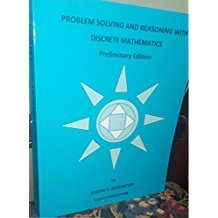Book Review: PROBLEM SOLVING AND REASONING WITH DISCRETE MATHEMATICS by Dr. Joseph G. Rosenstein
US K-12 mathematics has long been dominated by the notion that any legitimate pathway through high school and into college requires passing over Calculus Mountain. It isn’t a real mountain, but it might as well be for those who wish to pursue certain professions, not all of which actually make use of calculus at the graduate or professional school level or indeed in those professions in the field. In particular, medicine, dentistry, veterinary medicine, and other prestigious branches of “the healing arts” make calculus an absolute hurdle for those who wish to qualify for professional training. And the results can be harmful not only to individuals who are thus shut out because they can’t get over Calculus Mountain but to the professions themselves and the public they serve. Few doctors outside of those doing research ever use one lick of calculus outside of their undergraduate education, but only those who can “cut it” for four semesters in college are going to get into the requisite professional schools. And not all those who make it are necessarily the best-suited to be healers; neither are all those who are kept out necessarily otherwise ill-qualified.
The above issues aside, there seems to be a factor of inertia and traditionalism that keeps calculus as the “One True Grail” for school mathematics. And to ask why this need be the only path for our students is to risk being branded a heretic. One person who has challenged the received wisdom is Dr. Joseph G. Rosenstein, an emeritus professor of mathematics at Rutgers University. He’s done so not by attacking analysis, but by offering a major alternative for students in K-12: discrete mathematics. In the introduction to his textbook, PROBLEM SOLVING AND REASONING with DISCRETE MATHEMATICS, he writes that the text, “addresses five types of issues related to problem solving and reasoning: (a) strategies for solving problems, (b) thinking and acting systematically, (c) mathematical reasoning, (d) mathematical modeling, and (e) mathematical practice. Although many of the mathematical topics in this book are not addressed in the current version of the Common Core State Standards, these five types of issues play a major role in what the standards refer to as “Standards for Mathematical Practice.”
Dr. Rosenstein’s textbook offers a coherent treatment of a major strand of mathematics that has many of the most important qualities of both abstract and applied math, including rigorous thinking and proving, utility, and beauty, all of which can be accessible to K-12 students who many not necessarily have been drawn to or successful with every aspect of the traditional curriculum. In these senses, Rosenstein provides a pathway that exemplifies the heart and soul of the Standards for Mathematical Practice, the piece of the Common Core Mathematics Standards that to my thinking exists above and beyond any particular list or sequencing of topics in the Content Standards.
Further, his book is eminently accessible to a broad range of students and teachers. He has selected from the most appealing areas of discrete mathematics, starting with coloring, graphs, counting, and paths and circuits, all of which provide students with the opportunity to dive into serious math and be successful with it. The problems are chosen to be thought-provoking and engaging, with a mix of the concrete, the abstract, the applied, and the esthetic. Teachers who are not themselves deeply familiar with one or more of the topics can readily explore discrete mathematics with students in ways that
would benefit everyone. Those who have a background in discrete mathematics will find plenty of familiar and new problems to challenge both their students and themselves.
As someone who loves discrete mathematics, I am truly excited to see this book appear just at a time when the United States needs to find alternatives for students who have not been well-served by the traditional curriculum for K-12 math. While no textbook can guarantee that it will instantly make students love mathematics who have heretofore feared and loathed the subject, I believe Rosenstein’s book comes close to offering a vast range of students a tempting invitation to reconsider math as something enjoyable, beautiful, and perhaps most importantly, understandable. Nothing breeds success like success, and with this book, students will be able to succeed in authentic mathematical problem-solving, regardless of previous experiences.


The Textile industry is in a period of rapid and revolutionary modernization and automation in India. The engineers graduated in Textile Engineering are equipped with the knowledge of the behavior of textile materials and the functions of machinery in textile and clothing technologies.
The contents are very helpful. As you described the five types of issues and the solutions like problem-solving and reasons behind the problems, systematically techniques, mathematical reasons behind, modeling and practice. Thanks a lot for sharing.
Nice write-up
I’ve bookmarked your site
I believe that the book will fill a need not only for students who have not been attracted to mathematics, but for all those teachers who want to teach strategies for posing and solving problems, as well as for all those who are faced with a problem for the first time without resources to understand and solve it. Practice makes perfect: this seems to be the premise on which Dr. Rosenstein’s book is founded, which reminds me of one of George Polya’s pioneering problem solving books, How to Solve It. According to Polya, the key to learning how to solve problems is to gain experience solving them and seeing how others solve them. Dr. Rosenstein’s work promises to be an attractive and valuable tool for the student community, which will facilitate the learning of mathematics and open the way to understand the essence of mathematics through its practice.